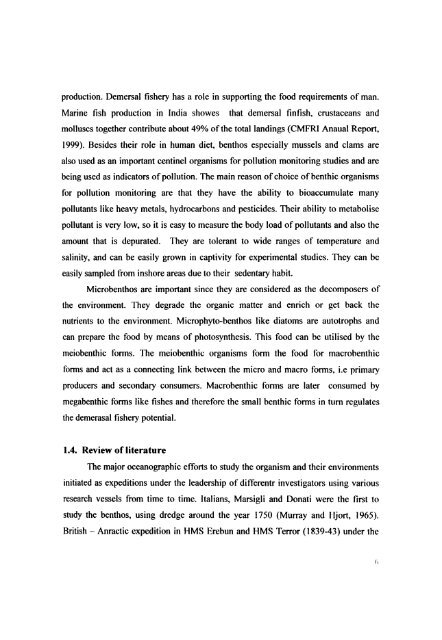L - Cochin University of Science and Technology
L - Cochin University of Science and Technology
L - Cochin University of Science and Technology
You also want an ePaper? Increase the reach of your titles
YUMPU automatically turns print PDFs into web optimized ePapers that Google loves.
production. Demersal fishery has a role in supporting the food requirements <strong>of</strong> man.<br />
Marine fish production in India showes that demersal finfish, crustaceans <strong>and</strong><br />
molluscs together contribute about 49% <strong>of</strong> the total l<strong>and</strong>ings (CMFRI Anaual Report,<br />
1999). Besides their role in human diet, benthos especially mussels <strong>and</strong> clams are<br />
also used as an important centinel organisms for pollution monitoring studies <strong>and</strong> are<br />
being used as indicators <strong>of</strong> pollution. The main reason <strong>of</strong> choice <strong>of</strong> benthic organisms<br />
for pollution monitoring are that they have the ability to bioaccumulate many<br />
pollutants like heavy metals, hydrocarbons <strong>and</strong> pesticides. Their ability to metabolise<br />
pollutant is very low, so it is easy to measure the body load <strong>of</strong> pollutants <strong>and</strong> also the<br />
amount that is depurated. They are tolerant to wide ranges <strong>of</strong> temperature <strong>and</strong><br />
salinity, <strong>and</strong> can be easily grown in captivity for experimental studies. They can be<br />
easily sampled from inshore areas due to their sedentary habit.<br />
Microbenthos are important since they are considered as the decomposers <strong>of</strong><br />
the environment. They degrade the organic matter <strong>and</strong> enrich or get back the<br />
nutrients to the environment. Microphyto-benthos like diatoms are autotrophs <strong>and</strong><br />
can prepare the food by means <strong>of</strong> photosynthesis. This food can be utilised by the<br />
meiobenthic forms. The meiobenthic organisms form the food for macrobenthic<br />
forms <strong>and</strong> act as a connecting link between the micro <strong>and</strong> macro forms, i.e primary<br />
producers <strong>and</strong> secondary consumers. Macrobenthic forms are later consumed by<br />
megabenthic forms like fishes <strong>and</strong> therefore the small benthic forms in turn regulates<br />
the demerasal fishery potential.<br />
1.4. Review <strong>of</strong> literature<br />
The major oceanographic efforts to study the organism <strong>and</strong> their environments<br />
initiated as expeditions under the leadership <strong>of</strong> differentr investigators using various<br />
research vessels from time to time. Italians, Marsigli <strong>and</strong> Donati were the first to<br />
study the benthos, using dredge around the year 1750 (Murray <strong>and</strong> I-Ijort, 1965).<br />
British - Anractic expedition in HMS Erebun <strong>and</strong> HMS Terror (1839-43) under the

















